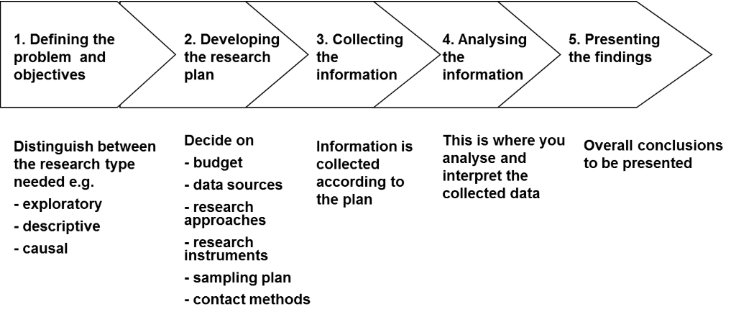How to do Market Research: A 5 Step Guide to Success
The focus of the Marketing Research Process is to identify the information that we need.

- Step 1. Defining the Problem and Objectives
This is perhaps the most important step in the market research process as it defines the objectives or goals of the project. It is also the most difficult stage to get right. Often people confuse the research problem with a symptom such as sales decrease, loss of market share, loss of key customers, high employee turnover, poor profits, etc. The easiest way to think of this is that a problem has a solution whereas a symptom helps you to identify a problem. For instance, in medical practice, symptoms help the doctor to identify the health problem, but if the doctor treats the symptoms, the underlining medical problem will still be there and if it goes on treated it could cause real health issues. The same is true in business.
Inadequate problem definition is the main cause of failure of a marketing research project and only when the marketing research problem has been clearly defined, should the research be designed and conducted properly. Problem definition involves stating the general marketing research problem and identifying its specific components. A clear statement of objectives will help you develop effective research. It will help the decision makers evaluate your project. It’s critical that you have manageable objectives. (Two or three clear goals will help to keep your research project focused and relevant.)
- Step 2. Developing the Research Plan
Once you know what the problem is you’re addressing, it’s time to develop and design the research plan. This step incorporates a number of parts.
- Decide the research approach – There are different ways to approach the research problem specifically, a quantitative approach or a qualitative one. As the name implies, a quantitative approach is used to quantify the problem by way of generating numerical data of attitudes, opinions, and behaviours, and to statistically generalize results to a larger population. Whereas, a qualitative approach is primarily exploratory in nature and tends to be used when you do not really understand the phenomenon that we are investigating and we want to do a deep dive into the problem in order get an understanding of underlining reasons or motivations.
- Develop a Data Collection Instrument: Each research approach has different data collection instruments. A quantitative approach tends to use surveys (Mail, telephone, person or online) or observation (counting the number of times a phenomenon happens). The most common research instrument is the questionnaire. Common qualitative data collection instruments are interviews and focus groups (a group of respondens moderated by the researcher).
- Develop a sampling plan: Your research sample are the individuals in the population that you intended to conduct research with.In your sample plan, you must detail who will be your research targets or audience. The sample size is based on level of accuracy required, cost of acquiring additional sample units, and the level of variability in data. Selecting your sample can be based upon (i) convenience – sampling what is convenient to you and what you can get (ii) Judgemental – where the research makes a judgement call and (iii) Quota- the researcher deliberately sets the proportions of levels or strata within the sample such as religion, sex etc
Step 3. Collecting all information:
In this step, you execute your sampling plan and collect the information from your target audience. This is an existing part of the research process. Ensure that you record all the information and treat it as precious.
Step 4. Analysing the information
Once you’ve gathered information, it’s time to interpret the data. There are a software packages for both quantitative (SPSS) and qualitative (Nvico) research approaches that can help you manage the data. When analysing your data, what you are looking for are patterns or common themes in the data. The key to successful data analysis is to immerse yourself in the data. Do not worry in the beginning if you feel confused or overwhelmed in the data. That is natural. Just persevere – keep reading, analysing, building summary tables, charts, flow diagram, mind maps etc. but most importantly – keep thinking about the data. The trends in the data will start to emerge and you will have that Eureka-insight moment – but only when you have the hard work of analysis done.
Step 5. Present the findings
Now it is time to compile the key take-away insights from the analysis. A great way to structure insights is to start with your research problem and objectives and put the key insights under each one.

